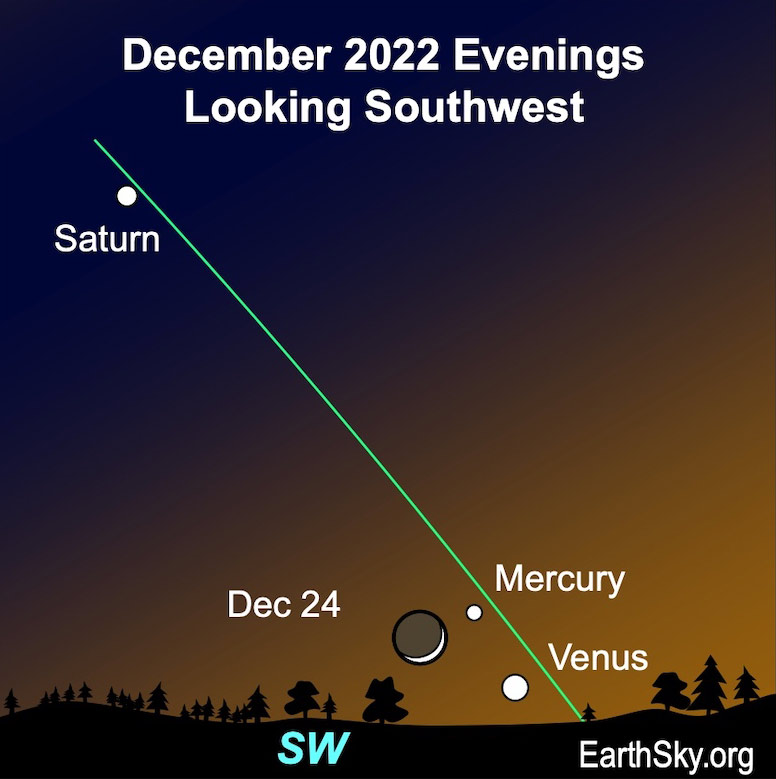Christmas Eve 'Trinity' Above Washington / Oregon Coast? Holiday Beach Astronomy
Published 12/14/22 at 3:25 AM
By Oregon Coast Beach Connection staff

Includes exclusive listings; some specials in winter
In Cannon Beach:
Includes rentals not listed anywhere else
In Manzanita, Wheeler, Rockaway Beach:
Some specials for winter
In Pacific City, Oceanside:
Some specials for winter
In Lincoln City:
Some specials for winter
In Depoe Bay, Gleneden Beach:
Some specials for winter
In Newport:
Look for some specials
In Waldport
Some specials for winter
In Yachats, Florence
Some specials for winter
Southern Oregon Coast Hotels / Lodgings
Reedsport to Brookings, places to stay; winter deals
(Oregon Coast) – The holidays always create a special vibe along the Oregon coast and Washington coast. But what about above them? (Graphic copyright Oregon Coast Beach Connection, showing Cannon Beach's Ecola State Park and the conjunction in its approximate location)
This year, you could be seeing what's nicknamed The Christmas Eve “Trinity” overhead, not just on the Washington coast or Oregon coast but in many places around the world. Two fairly bright planets will be clustered close to the moon low on the horizon, making an especially bright kind of conjunction in the “black” (as one famous show called it). It's supposed to be a rather stunning triangle low in the SW skies.
Even before then, the Geminids should still be raging overhead, one of the brightest meteor showers of the year. They end on the 24th.
The Christmas Eve Trinity is usually referred to just a conjunction, but some publications have opted for the more glittery term. You'll want to look low in the SW. That will be easy from the coastlines of Oregon or Washington, from places like Westport, Manzanita, Port Orford or Yachats. Take a gander of the area about 30 minutes after sunset (which will be about 4:30 p.m. for most of the Pacific Northwest).
This lovely triangle, according to EarthSky.org, will only be around for 30 or 40 minutes. Binoculars are suggested if you really want to take it in full effect. From the moon, you should get that ethereal earthshine, where the sun reflects back on the new moon, lighting it up faintly. It's a rather spectacular sky detail all its own.
Nearby will be the reddish Mercury and the bright Venus. A ways above all that will be Saturn, creating what EarthSky termed a “creamy light.”
All this, of course, is weather dependent: See Oregon Coast Weather - Washington Coast Weather
This soaring triangle is described as being a bit like a Christmas ornament.
Both planets will have set by 6 p.m., out of view from the Oregon coast, Washington coast or areas like Seattle and Portland.
The planet Mercury will reach its longest elongation on the 21st, which means it's sticking incredibly low to the horizon for awhile.

Graphic EarthSky.org
More interstellar fun begins on December 21 with the winter solstice, with the sun reaching that official point at 1:47 p.m. in the Northwest. This brings almost the shortest day of the year (it's actually one of three). From the solstice come the various Pagan / ancient UK traditions that created much of the Christmas themes we have today.
Also something to look forward around this time of year: sunset colors along the Oregon coast or Washington coast.
Awhile back, Jim Todd, astronomy expert with Portland's OMSI, told Oregon Coast Beach Connection:
“Because of the low angle of the sun's arc, it will produce the longest and most spectacular sunrises and sunsets of the year,” Todd said.
Sunsets literally linger a tiny bit longer, he said. The end of twilight is defined as when the sun dips 18 degrees below the horizon. Todd said this point is reached more quickly in the summer than in the winter, again because of the arc of the sun.
Also coming on Christmas Eve are the next round of Oregon coast / Washington coast king tides. Next King Tides Close to 10 ft.: What's New for Oregon Coast, Washington Coast
Oregon Coast Hotels for this event - South Coast Hotels - Where to eat - Maps - Virtual Tours
Cannon Beach Lodging
Nehalem Bay Lodgings
Manzanita Hotels, Lodging
Three Capes Lodging
Pacific City Hotels, Lodging
Lincoln City Lodging
Depoe Bay Lodging
Newport Lodging
Waldport Lodging
Yachats Lodging
Oregon Coast Vacation Rentals
Oregon Coast Lodging Specials

Moonlight on water at Manzanita

Bandon at night, courtesy Manuela Durson, see Manuela Durson Fine Arts for more
More About Oregon Coast hotels, lodging.....
More About Oregon Coast Restaurants, Dining.....
LATEST Related Oregon Coast Articles
One large-scale report from Long Beach still to be determined. Marine sciences
Manzanita's Spanish Galleon: New Discoveries and a Talk in N. Oregon Coast's ...
Saturday, November 15: The Beeswax Wreck of 1693. History, Nehalem events
N. Oregon Coast's Ecola State Park Closed Due to Landslides That Cracked Road
This part of Cannon Beach is prone to hillside movement: Indefinate closure. Weather, safety
55 Years of 'Happy Exploding Whale Day' Celebrated in Oregon Coast's Florence
Nov 12 is the holiday, but Florence's celebrates Nov 16. Florence events, south coast events, Newport events
Cannon Beach's Hug Point Erosion: N. Oregon Coast Fave Shut Down For Now
Closed indefinitely as repairs are extremely complex. Weather
Oregon Coast's Crabbing Fleet Heads Out with Whale Entanglement Advisory
Environmental groups petition ODFW for greater whale safety measures. Marine sciences
Intense Aurora Photos from Washington, Oregon Coast - More Possible Tonight
Photos from Seattle to California, including how to see it again. Weather, astronomy
Commercial Crabbing Cleared for December 16 Opening on Majority of Oregon Coast
Over two-thirds of the coast reopens: the rest hopefully Dec 31. Sciences
Back to Oregon Coast
Contact Advertise on Oregon Coast Beach Connection
All Content, unless otherwise attributed, copyright Oregon Coast Beach Connection. Unauthorized use or publication is not permitted



















































